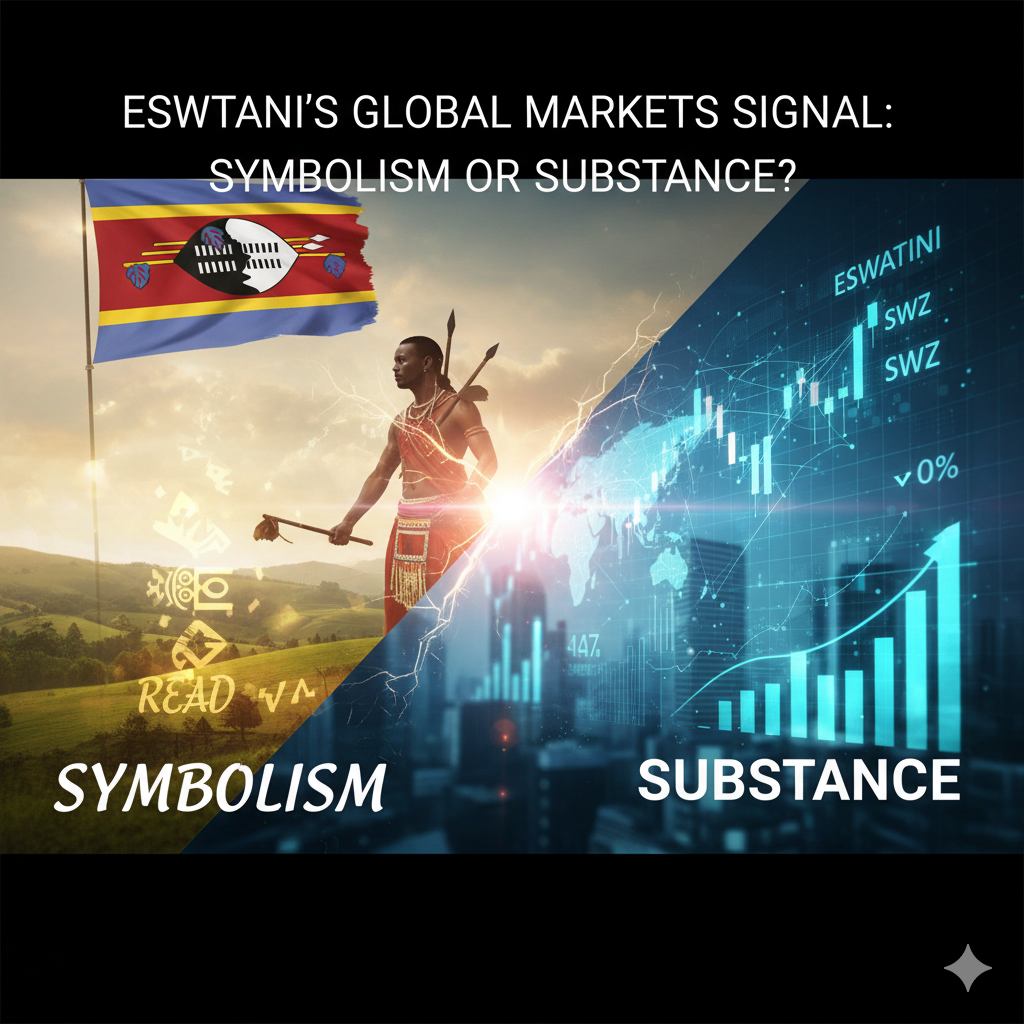eSwatini’s Global Markets Signal: Symbolism or Substance?
Eswatini pledges USD 5m to ASIA, but with debt at 43% of GDP, deficits near 5%, and reserves covering just 2.4 months of imports, global markets won’t budge—USD/ZAR (17.32) and SAGB yields (9.07%) remain the real tickers to watch.

eSwatini’s Finance Minister Neal Rijkenberg stood in New York this month, pledging USD 5 million on behalf of King Mswati III to the Africa Strategic Investment Alliance (ASIA) Global Partners Platform. The optics of the announcement were carefully staged: the world’s last absolute monarchy promising to back small business and financial inclusion in Africa’s global financial capital. Yet in market terms, the question is unavoidable—does a USD 5 million pledge from a USD 5.5 billion economy move the needle for investors watching Bloomberg terminals and bond screens? The short answer is no.
The numbers tell the story. eSwatini is a small state whose fiscal health depends on volatile transfers from the Southern African Customs Union (SACU). In FY 2024/25, the deficit widened to 2.3 percent of GDP even as SACU receipts were relatively strong. The IMF projects that as those receipts decline in FY 2025/26, the deficit will rise to 4.7 percent, while debt climbs to 42.9 percent of GDP. Public debt has already grown from about 31 percent of GDP in 2019/20 to more than 40 percent today. Foreign reserves, meanwhile, cover only 2.4 months of imports, far below the four-month benchmark typically cited by multilaterals as a safety line. These metrics define investor perception far more than political declarations, and they point to a country with little room for error.
Debt pricing confirms the caution. In July 2025, Mbabane issued a ZAR 600 million five-year bond in Johannesburg at 12.175 percent, sharply above the yields of comparable South African Government Bonds. At present, the SAGB 5-year trades near 7.87 percent, the 10-year sits at 9.07 percent, and the 30-year around 10.30 percent. Investors demand spreads of roughly 375 basis points to hold eSwatini’s paper, reflecting structural risks and fiscal volatility. That premium is unlikely to narrow because of a symbolic pledge, however well intentioned, and will only respond to measurable improvements in debt sustainability and reserves.
Currency mechanics underscore the point. The Swazi lilangeni (SZL) is pegged 1:1 to the South African rand (ZAR) within the Common Monetary Area, making USD/ZAR the operative ticker for investors. At present, the rand trades near 17.32 to the dollar. With the peg in place, the Central Bank of Eswatini sets its policy rate in near-lockstep with the South African Reserve Bank, currently at 6.75 percent versus SARB’s 7 percent. There is no independent SZL curve, no floating risk premium, and no FX play that can be made on Swazi fundamentals. For traders, Swazi news simply feeds through South African macro drivers, reinforcing the sense that eSwatini is a derivative of ZAR risk rather than a standalone story.
That structural dependence on Pretoria also defines the fiscal side. SACU transfers often make up more than half of central government revenue, which means that South Africa’s growth performance and trade cycle directly determine whether Mbabane runs a surplus or scrambles for financing. A downturn in South African customs receipts is effectively imported as a fiscal crisis in eSwatini. Analysts at Brookings have highlighted how this volatility erodes resilience in small states, and in eSwatini’s case it has repeatedly forced borrowing cycles and arrears when SACU inflows dropped. With transfers expected to decline in FY 2025/26, the outlook is worsening. Markets see this linkage as permanent and price it into the spread premium.
The ASIA pledge could matter only in specific conditional scenarios. If the platform evolves into a USD 200–300 million facility with development bank backing and first-loss guarantees, it could reduce non-performing loan ratios, lower bank funding costs, and help rebuild reserves toward four months of import cover. That, in turn, could narrow the spread premium above SAGBs and provide a modest credit uplift. If the government also delivers fiscal consolidation despite lower SACU receipts—by containing the wage bill and improving tax collection—investors might reward credibility with tighter pricing. These are tangible metrics that could eventually shift bond screens, but they require execution and scale far beyond a USD 5 million gesture.
For context, compare Kenya’s USD 2 billion Eurobond rollover in 2024 or Nigeria’s multi-billion-dollar market taps. South Africa raises billions of rand every month in Treasury auctions. Against those benchmarks, eSwatini’s entire GDP is smaller than a single Kenyan issuance. The pledge to ASIA, while valuable for political signaling, is invisible in global markets where portfolio managers track tickers like KENINT, NGERIA, or GHANA for direction. EMBI spreads across Sub-Saharan Africa did not move on the news, because the amounts involved were immaterial.
Still, Mbabane cannot be ignored entirely. The IMF’s Article IV statement in August 2025 pointed out that growth could rebound to 4.3 percent in 2025 after slowing to 2.8 percent in 2024, suggesting some upside potential. It also flagged that with credible consolidation, wage restraint, and arrears clearance, debt dynamics could stabilize. Markets will focus on whether reserves can rebuild from 2.4 months toward 4 months, whether deficits can be narrowed even as SACU transfers fall, and whether ASIA-related inflows materialize as hard dollars. Those are quantifiable factors that can shift spreads and credit ratings.
The near-term outlook is neutral. In the base case, Eswatini’s ASIA pledge is market-irrelevant: no impact on USD/ZAR, no repricing of SAGBs, and no movement in SSA credit spreads. Debt continues to inch upward, reserves remain under strain, and SACU volatility drives fiscal results. The upside case—a fully capitalized ASIA facility, stronger reserves, and credible fiscal rules—could compress spreads modestly, while the downside case—a SACU collapse without consolidation—would widen spreads further and trigger liquidity stress. For now, the prudent investor stance is to treat Eswatini as a high-beta overlay on South Africa rather than a driver of its own.
Global markets will always notice symbolism, but they only reprice on scale, certainty, and instruments. Until reserves rise, fiscal anchors hold, and flows materialize, Eswatini remains outside the circle of market movers. The conclusion is as stark as the data: watch the numbers, not the declarations.





